Adapted from the notes in the course, which I don't see available (including this derivation) outside the notes contributed by students within the page of Andrew Ng's Coursera Machine Learning course.
In what follows, the superscript $(i)$ denotes individual measurements or training "examples."
$\small
\frac{\partial J(\theta)}{\partial \theta_j} =
\frac{\partial}{\partial \theta_j} \,\frac{-1}{m}\sum_{i=1}^m
\left[ y^{(i)}\log\left(h_\theta \left(x^{(i)}\right)\right) +
(1 -y^{(i)})\log\left(1-h_\theta \left(x^{(i)}\right)\right)\right]
\\[2ex]\small\underset{\text{linearity}}= \,\frac{-1}{m}\,\sum_{i=1}^m
\left[
y^{(i)}\frac{\partial}{\partial \theta_j}\log\left(h_\theta \left(x^{(i)}\right)\right) +
(1 -y^{(i)})\frac{\partial}{\partial \theta_j}\log\left(1-h_\theta \left(x^{(i)}\right)\right)
\right]
\\[2ex]\Tiny\underset{\text{chain rule}}= \,\frac{-1}{m}\,\sum_{i=1}^m
\left[
y^{(i)}\frac{\frac{\partial}{\partial \theta_j}h_\theta \left(x^{(i)}\right)}{h_\theta\left(x^{(i)}\right)} +
(1 -y^{(i)})\frac{\frac{\partial}{\partial \theta_j}\left(1-h_\theta \left(x^{(i)}\right)\right)}{1-h_\theta\left(x^{(i)}\right)}
\right]
\\[2ex]\small\underset{h_\theta(x)=\sigma\left(\theta^\top x\right)}=\,\frac{-1}{m}\,\sum_{i=1}^m
\left[
y^{(i)}\frac{\frac{\partial}{\partial \theta_j}\sigma\left(\theta^\top x^{(i)}\right)}{h_\theta\left(x^{(i)}\right)} +
(1 -y^{(i)})\frac{\frac{\partial}{\partial \theta_j}\left(1-\sigma\left(\theta^\top x^{(i)}\right)\right)}{1-h_\theta\left(x^{(i)}\right)}
\right]
\\[2ex]\Tiny\underset{\sigma'}=\frac{-1}{m}\,\sum_{i=1}^m
\left[ y^{(i)}\,
\frac{\sigma\left(\theta^\top x^{(i)}\right)\left(1-\sigma\left(\theta^\top x^{(i)}\right)\right)\frac{\partial}{\partial \theta_j}\left(\theta^\top x^{(i)}\right)}{h_\theta\left(x^{(i)}\right)} -
(1 -y^{(i)})\,\frac{\sigma\left(\theta^\top x^{(i)}\right)\left(1-\sigma\left(\theta^\top x^{(i)}\right)\right)\frac{\partial}{\partial \theta_j}\left(\theta^\top x^{(i)}\right)}{1-h_\theta\left(x^{(i)}\right)}
\right]
\\[2ex]\small\underset{\sigma\left(\theta^\top x\right)=h_\theta(x)}= \,\frac{-1}{m}\,\sum_{i=1}^m
\left[
y^{(i)}\frac{h_\theta\left( x^{(i)}\right)\left(1-h_\theta\left( x^{(i)}\right)\right)\frac{\partial}{\partial \theta_j}\left(\theta^\top x^{(i)}\right)}{h_\theta\left(x^{(i)}\right)} -
(1 -y^{(i)})\frac{h_\theta\left( x^{(i)}\right)\left(1-h_\theta\left(x^{(i)}\right)\right)\frac{\partial}{\partial \theta_j}\left( \theta^\top x^{(i)}\right)}{1-h_\theta\left(x^{(i)}\right)}
\right]
\\[2ex]\small\underset{\frac{\partial}{\partial \theta_j}\left(\theta^\top x^{(i)}\right)=x_j^{(i)}}=\,\frac{-1}{m}\,\sum_{i=1}^m \left[y^{(i)}\left(1-h_\theta\left(x^{(i)}\right)\right)x_j^{(i)}-
\left(1-y^{i}\right)\,h_\theta\left(x^{(i)}\right)x_j^{(i)}
\right]
\\[2ex]\small\underset{\text{distribute}}=\,\frac{-1}{m}\,\sum_{i=1}^m \left[y^{i}-y^{i}h_\theta\left(x^{(i)}\right)-
h_\theta\left(x^{(i)}\right)+y^{(i)}h_\theta\left(x^{(i)}\right)
\right]\,x_j^{(i)}
\\[2ex]\small\underset{\text{cancel}}=\,\frac{-1}{m}\,\sum_{i=1}^m \left[y^{(i)}-h_\theta\left(x^{(i)}\right)\right]\,x_j^{(i)} \\[2ex]\small=\frac{1}{m}\sum_{i=1}^m\left[h_\theta\left(x^{(i)}\right)-y^{(i)}\right]\,x_j^{(i)}
$
The derivative of the sigmoid function is
$\Tiny\begin{align}\frac{d}{dx}\sigma(x)&=\frac{d}{dx}\left(\frac{1}{1+e^{-x}}\right)\\[2ex]
&=\frac{-(1+e^{-x})'}{(1+e^{-x})^2}\\[2ex]
&=\frac{e^{-x}}{(1+e^{-x})^2}\\[2ex]
&=\left(\frac{1}{1+e^{-x}}\right)\left(\frac{e^{-x}}{1+e^{-x}}\right)\\[2ex]
&=\left(\frac{1}{1+e^{-x}}\right)\,\left(\frac{1+e^{-x}}{1+e^{-x}}-\frac{1}{1+e^{-x}}\right)\\[2ex]
&=\sigma(x)\,\left(\frac{1+e^{-x}}{1+e^{-x}}-\sigma(x)\right)\\[2ex]
&=\sigma(x)\,(1-\sigma(x))
\end{align}$


